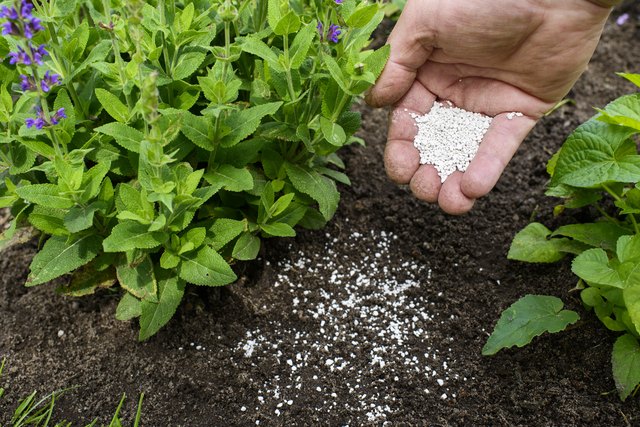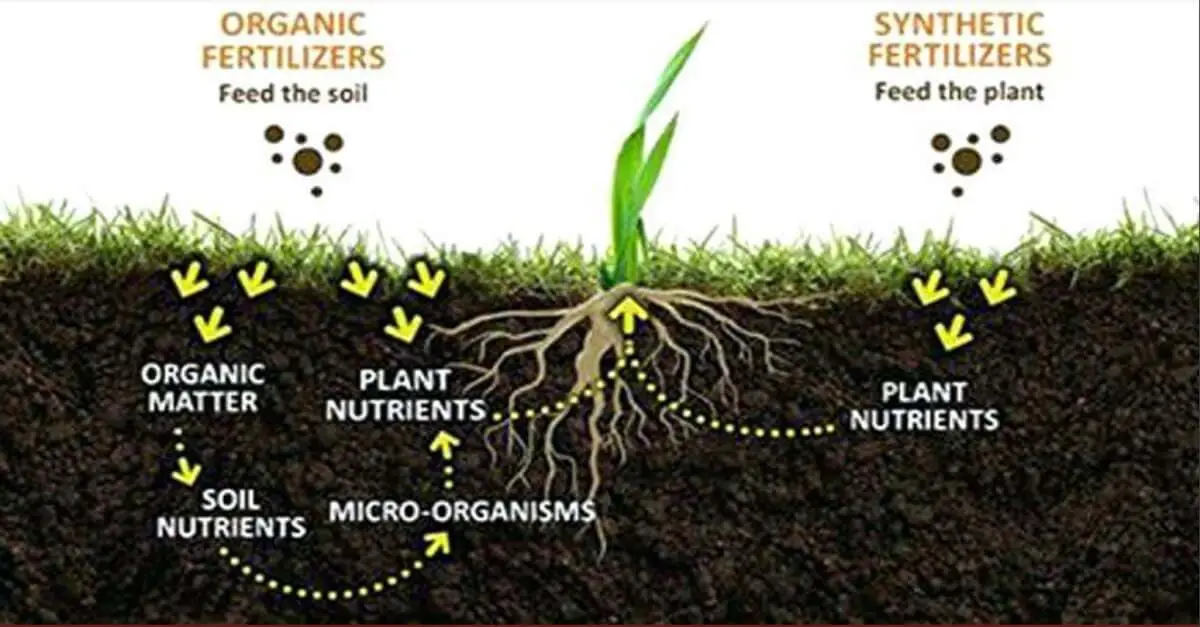Wheat is a staple crop that requires specific soil management and fertilization practices to achieve ...
Fertilizers are essential substances used in agriculture to enhance the growth and productivity of crops. They provide vital nutrients to plants that may not be sufficiently available in the soil, ensuring healthy growth and higher yields. Understanding the types of fertilizers and their application is crucial for successful farming.
खेती में खाद का महत्वपूर्ण स्थान है। खाद के माध्यम से मिट्टी में आवश्यक पोषक तत्वों की आपूर्ति होती है, जिससे फसलों की बेहतर वृद्धि और उत्पादन सुनिश्चित किया जा सकता है। खाद के सही और संतुलित उपयोग से मिट्टी की उर्वरकता को बनाए रखा जा सकता है, जिससे लम्बे समय तक खेती की गुणवत्ता बरकरार रहती है। इसके अलावा, जैविक खादों का उपयोग करके मिट्टी की संरचना और पर्यावरणीय संतुलन को भी सुधारा जा सकता है। आइए, इस लेख में हम खाद के विभिन्न प्रकारों, उनके उपयोग और महत्व के बारे में विस्तार से जानें...
खाद मुख्यतः दो प्रकार की होती है - जैविक खाद और रासायनिक खाद। दोनों का अपना-अपना महत्व है और फसलों के लिए अलग-अलग परिस्थितियों में उपयोग किया जाता है।
जैविक खाद, जिसे ऑर्गेनिक फर्टिलाइजर भी कहते हैं, प्राकृतिक स्रोतों से प्राप्त होती है। इसमें गोबर, कम्पोस्ट, हरी खाद, और अन्य प्राकृतिक पदार्थ शामिल होते हैं। जैविक खाद मिट्टी की संरचना को सुधारती है और उसकी उर्वरकता को बढ़ाती है।
रासायनिक खाद, जिसे इनऑर्गेनिक या सिंथेटिक फर्टिलाइजर भी कहा जाता है, विभिन्न रासायनिक तत्वों से निर्मित होती है। इसमें मुख्यतः नाइट्रोजन, फॉस्फोरस, और पोटेशियम जैसे तत्व शामिल होते हैं। यह खाद तेजी से फसलों को पोषक तत्व उपलब्ध कराती है और फसल उत्पादन को बढ़ावा देती है।

खाद का मुख्य कार्य मिट्टी में आवश्यक पोषक तत्वों की पूर्ति करना है। यह फसलों की जड़ों को मजबूत बनाती है, जिससे पौधों की वृद्धि बेहतर होती है। खाद के सही उपयोग से फसल की गुणवत्ता और उत्पादन में सुधार होता है।
खाद का उपयोग करते समय मिट्टी की जांच कराना महत्वपूर्ण है ताकि सही प्रकार और मात्रा की खाद का चयन किया जा सके। जैविक खाद को खेत में पहले से मिलाना चाहिए, जबकि रासायनिक खाद को फसल की आवश्यकता के अनुसार समय-समय पर देना चाहिए।
खाद का अत्यधिक उपयोग फसलों और मिट्टी के लिए हानिकारक हो सकता है। रासायनिक खाद का अधिक उपयोग मिट्टी की उर्वरकता को नुकसान पहुँचा सकता है और पर्यावरण पर भी बुरा असर डाल सकता है। इसलिए, खाद का उपयोग संतुलित मात्रा में और सही समय पर करना जरूरी है।
खेती में खाद का सही उपयोग फसल की सेहत और उत्पादन के लिए बहुत महत्वपूर्ण है। हर फसल को अपनी विकास प्रक्रिया के दौरान अलग-अलग पोषक तत्वों की आवश्यकता होती है। इन पोषक तत्वों की कमी को पूरा करने के लिए विभिन्न प्रकार की खादों का उपयोग किया जाता है।

नाइट्रोजन पौधों की वृद्धि और हरे पत्तों के विकास के लिए जरूरी है। अगर फसल में नाइट्रोजन की कमी होती है, तो पौधे की पत्तियाँ पीली पड़ने लगती हैं और वृद्धि रुक जाती है। यूरिया एक ऐसी खाद है जिसमें उच्च मात्रा में नाइट्रोजन होती है, और यह फसल में नाइट्रोजन की कमी को पूरा करने में मदद करती है।
फॉस्फोरस फसल की जड़ों की मजबूती और फूलों व फलों के विकास के लिए आवश्यक होता है। फॉस्फोरस की कमी से पौधे की जड़ें कमजोर हो जाती हैं और फूल व फल कम बनते हैं। डीएपी (डाय-अमोनियम फॉस्फेट) खाद फसल में फॉस्फोरस की कमी को पूरा करती है और पौधों की जड़ों को मजबूत बनाती है।
यह भी पढ़ें: सबसे अच्छा उर्वरक कौन सा है?
पोटाशियम पौधों में रोगों से लड़ने की क्षमता को बढ़ाता है और उनके संपूर्ण विकास में सहायक होता है। पोटाशियम की कमी से पौधे कमजोर हो जाते हैं और उनकी रोग प्रतिरोधक क्षमता घट जाती है। म्यूरेट ऑफ पोटाश (MOP) एक ऐसी खाद है जो फसल में पोटाशियम की कमी को दूर करने में मदद करती है।
फसल को स्वस्थ रखने के लिए नाइट्रोजन, फॉस्फोरस, और पोटाशियम के अलावा कई सूक्ष्म पोषक तत्वों की भी आवश्यकता होती है, जैसे जिंक, मैग्नीशियम, आयरन आदि। इन सूक्ष्म पोषक तत्वों की कमी को पूरा करने के लिए मिश्रित खाद का उपयोग किया जाता है, जिसमें कई प्रकार के सूक्ष्म पोषक तत्व शामिल होते हैं।

जैविक खाद, जैसे कि गोबर की खाद, कंपोस्ट, और वर्मीकम्पोस्ट, फसल के लिए समग्र पोषण प्रदान करती हैं। ये खादें मिट्टी की संरचना को सुधारती हैं, उसमें जीवांश की मात्रा बढ़ाती हैं और पौधों को धीरे-धीरे सभी जरूरी पोषक तत्वों की आपूर्ति करती हैं। जैविक खाद का उपयोग मिट्टी की दीर्घकालिक उर्वरकता को बनाए रखने के लिए भी किया जाता है।
फसल की जरूरतों को समझकर और सही खाद का उपयोग करके किसान अपनी पैदावार को बढ़ा सकते हैं और फसल की गुणवत्ता को सुधार सकते हैं। सही खाद का चुनाव न केवल फसल की कमी को पूरा करता है, बल्कि मिट्टी की उर्वरकता को भी बनाए रखता है। इस लेख में दिए गए सुझावों का पालन करके आप अपनी खेती को और भी अधिक सफल बना सकते हैं।खाद फसलों की वृद्धि और उत्पादन के लिए आवश्यक है, लेकिन इसका सही तरीके से उपयोग करना बहुत महत्वपूर्ण है। जैविक और रासायनिक खादों का संतुलित उपयोग करके आप अपनी फसल की गुणवत्ता को बढ़ा सकते हैं और बेहतर उत्पादन प्राप्त कर सकते हैं।
कृषि से संबंधित वीडियो देखने के लिए यहाँ क्लिक करें: YouTube
Nitrogen, phosphorus, and potassium are the three primary nutrients that plants require for growth. Nitrogen promotes leaf and stem growth, phosphorus aids in root development and flower formation, and potassium strengthens the plant's overall health, improving disease resistance and water retention. The right balance of these nutrients is vital for optimal crop production.
Fertilizer application methods vary depending on the type of crop, soil condition, and the specific fertilizer used. Common methods include broadcasting, where fertilizers are spread evenly across the soil surface, and banding, where they are applied in rows or bands close to the plant roots. Foliar feeding, where liquid fertilizers are sprayed directly onto plant leaves, is also a popular technique.
Selecting the appropriate fertilizer involves understanding the nutrient needs of your crops and the existing nutrient levels in your soil. Soil testing is an effective way to determine which nutrients are lacking and need to be supplemented. Based on the results, you can choose a fertilizer that best meets your crop's requirements, ensuring balanced nutrition.
Using fertilizers correctly can significantly increase crop yield and quality. Fertilizers enhance plant growth, improve soil fertility, and ensure that crops receive the essential nutrients they need. This leads to healthier plants, better resistance to pests and diseases, and ultimately, higher agricultural productivity.
While fertilizers are beneficial, overuse or incorrect application can lead to environmental damage and soil degradation. Excessive use of synthetic fertilizers can result in nutrient runoff, leading to water pollution and harming aquatic life. It’s important to follow recommended application rates and guidelines to avoid these negative impacts.
Fertilizers play a crucial role in modern agriculture, helping to meet the growing demand for food by boosting crop production. Understanding the types, uses, and best practices for applying fertilizers is essential for sustainable farming. By choosing the right fertilizers and using them wisely, farmers can ensure the long-term health of their soil and the success of their crops.
0
0
Wheat is a staple crop that requires specific soil management and fertilization practices to achieve ...
भारत में कृषि न केवल एक प्रमुख आर्थिक � ...
Neem cake is an organic byproduct derived from cold-pressed neem seeds after the extraction of neem ...
खरीफ फसलें-मानसून के मौसम में उगाई जात ...
Rice farming requires careful management of soil nutrients to ensure optimal growth and yield. The a ...
Mango farming is a significant agricultural practice in many tropical and subtropical regions. Known ...
Organic farming is an agricultural practice that focuses on growing crops and raising livestock in a ...
Crop rotation, a key agricultural practice, involves growing different crops in the same field acros ...
Soil fertility is crucial for any farmer or gardening enthusiast. Fertile soil promotes healthy plan ...
Soil testing is a process that provides farmers with crucial information about the quality, nutrient ...
The tradition of farming in India is centuries old, and wheat and barley hold significant importance ...
The Aak plant (Calotropis gigantea) is a remarkable creation of nature, valued for its distinctive f ...
Roses, known for their beauty and enchanting fragrance, are the pride of every garden. However, main ...
Agricultural Pollution refers to the harmful effects caused by agricultural activities on the enviro ...
Temperature fluctuations have a direct impact on wheat farming. It affects sowing, growth, grain for ...
During summer, rising temperatures increase the risk of fire in wheat crops. As April begins, wheat ...
Agroforestry is a term derived from two words: "Agriculture" and "Forestry." It is a land-use system ...
कृषि में आर्टिफिशियल इंटेलिजेंस (AI) क ...
Contour Farming is a very common farming technique practiced in India. It is commonly practiced in h ...
Vegetables to Sow in May : Dear farmer friends, in the month of May, our plants don't usually suff ...
Papaya is a highly nutritious fruit loaded with medicinal properties. Its consumption helps regula ...
India is an agrarian country with three major agricultural seasons and a variety of crops being prod ...
Leaf curl disease, which causes leaves to curl, is a serious threat to agriculture. This disease aff ...
Intercropping is a farming method where two or more crops are grown together in the same field. It h ...
Mulching is a layer spread over the surface of the soil, primarily aimed at retaining soil moistur ...
India is an agriculture-based country, yet many farmers can’t use their land as it remains barren ...